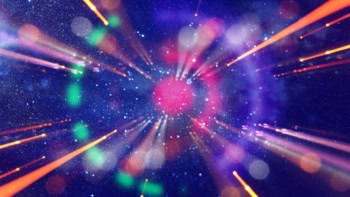
The early universe has been mimicked in the lab using a ring-shaped Bose-Einstein condensate (BEC) of ultracold atoms. Gretchen Campbell, Stephen Eckel and colleagues at the Joint Quantum Institute at the University of Maryland expanded the size of their ultracold atomic cloud at supersonic speed and observed several effects believed to be associated with the inflationary epoch of the early universe. This epoch is thought to have occurred less than 10–32 s second after the Big Bang when the universe expanded at an exponential rate.
Bose–Einstein condensates (BECs) are formed when identical atoms with integer spin are cooled until all the atoms are in the same low-energy quantum state. This means that a BEC comprising tens of thousands of atoms behaves as a single quantum entity. A BEC can be thought of as a vacuum state for phonons, which are quanta of vibrational mechanical energy. The team used this phonon vacuum as an analogy for the quantum field vacuum in the early universe.
In one experiment, the researchers introduced a sound wave onto their cloud to see how it evolved during expansion. The phonon wavelength increases (or redshifts) as the expansion occurs, thereby providing an analogy with how photons redshift in an expanding universe. They also saw that the amplitude of the wave decreases during expansion. The team has made a tentative connection between this effect and a strange cosmological damping phenomenon called “Hubble friction”.
End of an epoch
In another test, the team expanded the BEC with no sound waves, and watched it stabilize after it reached its maximum radius, a state analogous to the end of the universe’s inflationary epoch. Here, energy that had been powering inflation quickly translated into unstable BEC solitons and vortices, producing phonons.
“We see the creation of excitations in a way that is reminiscent of preheating and reheating in the early universe,” explain Campbell and Eckel. “After inflation, all of the energy in the universe was presumably contained within a quantum field that drove inflation called the ‘inflaton’. That field decayed, depositing its energy into lower mass particles causing the universe to heat up (hence, the term reheating).”
The team is now working to improve their expanding ring BEC model to better observe the damping they associate with Hubble friction. Looking future ahead, the physicists hope to generate correlated pairs of sound waves that mimic Hawking radiation from black holes. They also hope to simulate cosmological horizons by creating casually-disconnected regions in a condensate.
“Beautifully executed”
Although unconvinced by the connection with preheating and reheating, Silke Weinfurtner of the University of Nottingham thinks the experiments are “beautifully executed” and “a significant step forward in carrying out table-top analogue gravity experiments”. “Overall, analogue gravity cosmology experiments allow us to test some of the fascinating physics in a controlled laboratory setting,” she adds.

Can Bose–Einstein condensates simulate cosmic inflation?
Yet as with other analogue cosmology experiments, the key test will be if the researchers uncover new physics or confirm new cosmological theories: “We have already learned a lot from cosmology, but it’s not yet clear if we will in turn guide cosmology,” note Campbell and Eckel. “Our hope is that our system could provide a testbed where we could actually study new models and see what happens.”
The research is described in Physical Review X.



